Grant Stone Field Boot Review | Rugged Yet Luxurious
Grant Stone is quickly becoming one of the most popular Goodyear Welted boot brands on the boot scene today, and for good reason. Their flagship smart casual Diesel boot is an extremely versatile lace-up, and their Brass Boot is a robust yet luxurious moc toe that can be worn in business casual settings. (In fact, one of the guys at our office wears a pair.)
Being a blue-collar guy, most of the boots I own are work boots, and between working all day, a wife, and two kids under three, I don’t get the chance to wear my nicer boots out as much as I’d like to.
I really wanted to try Grant Stone, but I didn’t want a pair of Diesel or Brass boots collecting dust in the closet waiting for date night with the wife. Fortunately for me, they had just what I was looking for: the Field Boot which is a rugged yet semi-sophisticated outdoor boot that looked like it could also handle being worn to work.
Grant Stone Field Boot Key Takeaways
The Field Boot is a rugged, high quality boot built with premium materials at an excellent price.
From the premium leather uppers to the leather insole, welt, and midsole, Grant Stone spared no expense. While it’s a far cry from Grant Stone’s normal lineup of smart casual boots, the Field Boots offer a great alternative for those who want a tough, slightly sophisticated, traditionally made boot for the outdoors that doesn’t weigh 3lbs+ like many PNW boots.
However, considering it’s called “The Field Boot,” it would have been nice to have a fully gusseted tongue and more robust laces.
- Comfort: 5/5
- Durability 5/5
- Materials 5/5
- Design ⅘
- Value ⅘
Grant Stone Field Boot Pros and Cons
Here’s a quick summary of what I’ll write for you in the review below.
Pros
- World class leather options
- Premium leather components
- Relaxed forefoot, roomy last
- Goodyear welt construction
- Resoleable
World-class leathers, a relaxed forefoot, roomy last, and resolable Goodyear welt construction combine to make this casual yet rugged boot stand out in a sea of same-same moc toes.
Cons
- Lack of fully gusseted tongue
- D rings are not cumbersome and not as easy as speed hooks
- Stock laces seem a little delicate for a “Field Boot”
- Can’t be dressed up
How I Reviewed These Boots
So, how did I review these boots? I wore them at work at home, around town, and outside. Basically everywhere.
As a guy who wears work boots daily to a blue-collar trade job, who has written 18+ boot reviews between Stridewise and other websites, who has written numerous boot-related articles, and even edited other reviewer’s boot reviews before they were published, I think I have a pretty good take on whether or not a boot is quality.
Grant Stone Field Boot Aesthetics and Design
- Very casual
- Relatively low profile moc toe
- Wedge outsoles on all colorways
- 7 inches tall
- D rings instead of speed hooks
- Padded collar and heel stitch
The Field Boot is by far and away Grant Stone’s most casual boot. Standing at about seven inches tall from the welt up with robust D rings in place of speed hooks, a comfortable double padded collar, and a heel stitch to allow the boots to be easily kicked off, the Field Boot looks like it’s ready to take on anything. Grant Stone states in their own words that the Field boot is dedicated to “long weekends outdoors and that the boot is designed for walking, working and long weekend adventures.”
The design pattern Grant Stone used is based on the classic uplands hunting and hiking moc toe boot style, which is rarely seen outside of brands like Russell’s Moccasins and Rancourt. But those brands have genuine handsewn moccasin construction, while the Grant Stone Field Boot is not.
Let me briefly explain: in a true moccasin construction, the vamp is a single piece of leather that wraps around the bottom of the boot and is stitched to the midsole or outsole. Oftentimes, as is the case with many of the boots from Russell, you’ll see a leather panel running around the vamp that will also tie into the Moc toe stitching, depending on the boot. That panel is actually a separate piece of leather that is also wrapped around the bottom of the boot and acts as a molded sole.
In the Field Boot’s case, the vamp doesn’t wrap around the bottom of the sole or the side panel. In fact, the vamp is simply two pieces of leather that are overlapped and stitched together to give the appearance of a true moccasin construction.

Grant Stone Field Boot Leather Quality
- Waxed Commander (~1.5mm thick): A rugged, shrunken and waxed suede from C.F Stead. Great for patina nerds.
- Vegetable Tanned (~1.9mm): Saddle Tan Minerva from Badalassi Carlo in Italy. If you’re chasing patina, this will be your best option. Thickness: 1.8-2.0mm.
- Chromexcel leathers (~1.9mm): Black and Crimson from Horween. (Thickness: 1.8-2.0mm)
- Kudu leathers (~1.9mm): Both are from C.F Stead. One is Burgundy Kudu, and the other is Reverse Snuff Kudu, a roughout leather that’s had the grain side sanded down to Nubuck.
- Bison Leather (~2.1mm): One of the more distinct-looking leathers they offer and probably the hardest. The “Walnut” Bison is Tanned by Seidel.
- Ostrich Leather (~1.1mm) Unique, covered in feather marks. Heads will turn with this one. It will also run you a premium and costs about $200 more than the other Field boot options.
Personally, I went with the Earth Waxy Commander suede from C.F Stead, who is regarded as one of the best, if not the best, suede maker in the world. I really liked the Saddle Tan leather (see it in this Grant Stone Brass Boot review), but I own plenty of similar leathers, and I just wanted something different.
On top of developing an awesome patina, the waxed commander suede is very resilient, and C.F. Stead refers to it as a rugged fashion leather. Typically, the words “rugged” and “suede” won’t appear in the same sentence, but thanks to C.F. Stead’s unique tanning process, it’s possible. The reason Waxed Commander Suede is so hardwearing is due to the fact that C.F. Stead’s Tanning process shrinks the leather up to 25%, thus creating a very tight fiber structure that lends itself to being water resistant. On top of that, the leather is impregnated with C.F Stead’s blend of waxes, making the leather that much more water resistant.
[Learn more: See our visit to C.F. Stead in England]
Grant Stone Field Boot Construction and Durability
- Goodyear welt
- Resolable
- Veg Tanned Leather insole and cork layer
- Leather heel counter
- Leather midsole
- Wedge sole
Not only does Grant Stone use high quality leathers for the Field Boot’s upper, they also use what is considered the gold standard method of boot construction: a Goodyear welt.
Starting from the inside and working our way out, the boot features a 0.8-1.0mm thick leather lining in the vamp and heel area. (Only the shaft from the heel counter up is unlined.) The heel counter itself is full grain leather which will continually mold and adapt to your heel, the counter cover is roughout leather. The insole is full grain vegetable leather, which will mold to your foot, and below that is a layer of cork, which will also mold to the shape of your foot. Sitting in the cork is a steel shank for stability, which is rare in boots with flat wedge soles.
On the outside, you have a vegetable tanned leather welt, which makes a resole easier and cheaper, as leather welts last a long time and can oftentimes be reused by a cobbler. (Some cheaper boots get cred for being made with Goodyear welts, but the welt is plastic, making resoles very hard.)
Below that is thick, vegetable tanned leather midsole and EVA wedge sole, which together make the boots ultra comfortable for walking and standing for extended periods of time.
Grant Stone Field Boot Fit and Sizing
- Go a half size down from your Brannock size
- Consider going up a width if you have high insteps, a high volume foot, or wear thick socks.
- Relaxed forefoot and tall toe box allow your toes to have some wiggle room.
The Field Boot is built on Grant Stone’s Floyd last which is named after Grant Stone founder Wyatt Gilmore’s grandfather Floyd Gilmore a legendary Alden salesman.
The Floyd last is the same last used on Grant Stone’s popular Brass Boot. Floyd lasted boots feature a slightly more relaxed forefoot and high side walls around the toe box to make the boots comfortable for all day wear.
Grant Stone recommends going down a half size from your Brannock size. I went with a size 11 since my Brannock size is 11.5, but I did go up a width from D to an E width. The reason I did this is because I have a higher volume foot and higher insteps, plus I like to wear thick wool socks with my boots, and I had read that the Waxed Commander suede doesn’t really stretch at all due to its tight fiber structure.
So I decided to err on the side of caution and go with an E. It was definitely the right call, and if you look at my foot imprint in the leather insole, you’ll see the sizing is spot on.
Can You Work In Grant Stone Boots?
So can you work in the Field Boots? Grant Stone lists working as one thing the boots are designed for. Honestly, I’d say it depends.
Personally, I feel confident wearing them to the shop (I’m a sheet welder) for most tasks, but I wouldn’t wear them when I know I have a lot of grinding or mig welding to do. I definitely wouldn’t wear them out to a job site or while doing any serious work that tends to put a beating on boots.
The Field Boot is probably best suited for tasks that are a little easier on boots: finish carpentry, cabinet installer, drywall, that sort of thing. They’re also great for guys who are project managers or consultants who spend time at job sites but aren’t actually doing the physical work.
If you’re going to get them for work boots, I’d recommend the Walnut Bison leather first, as Bison leather is known for being soft but much stronger and more resilient than cowhides and other types of leather.
Second would be the Saddle Tan veg tanned leather, as veg tanned leather is also durable and hard-wearing. After that, I’d suggest the Waxed Commander because despite being considerably thinner than the other two, it’s still very durable and very water resistant because of that shrunken fiber structure.
Grant Stone Field Boot Price and Value
- $370 – 395
The Field Boot, like all Grant Stone boots, offers tremendous value for the money. Priced at $370-395 (with the exception of the $540 Ostrich leather), you get a lot of bang for your buck. You’re getting top notch leather options for the uppers, a veg tanned insole, leather midsole, leather welt and cork layer.
Not only are you getting premium leather and components for that price, but you are also getting extreme attention to detail. A good example is how tight and consistent the welt stitches are; they are far better and more consistent than my more expensive JK Forefronts and comparatively priced Goodyear welted White’s Springdales. It’s also better than any of my Red Wing boots.
It’s this reviewer’s opinion a Grant Stone boots would cost upwards of $600-700 if they were made here in the US. Definitely don’t let the fact they are made in China dissuade you. Grant Stones are top notch.
World-class leathers, a relaxed forefoot, roomy last, and resolable Goodyear welt construction combine to make this casual yet rugged boot stand out in a sea of same-same moc toes.
Things I liked about Grant Stone’s Field Boot
I definitely like the look: it definitely has a strong vintage vibe, like I raided my Grandpa’s closet and took a pair of his old boots. I definitely like the premium components that allow the boots to be resoled multiple times and the custom feel you get after breaking in the leather insole. The addition of a steel shank — again, rare for a wedge sole — gave me real confidence in the boots’ stability.
Things I didn’t like about Grant Stone’s Field Boot
I definitely didn’t like the fact it doesn’t have a fully gusseted tongue, especially considering that the Waxed Commander leather is so water resistant. I’m not the biggest fan of the D ring lace hooks, which take a little longer to lace up than speed hooks. Definitely didn’t like the thin waxed cotton laces that came with the boots.
Final Thoughts
All in all, I really love my Field boots and think they offer tremendous value, given the premium components Grant Stone used to make the boots.
Despite my few gripes, they are one of my favorite Moc Toe boots. If you don’t like the laces, I definitely recommend doing what I did: swapping them out for some chocolate leather laces and adding a waxed flesh kiltie from Dale’s Leather Works, which makes the boots feel even more robust than they already are. I definitely recommend the Grant Stone Field Boots.

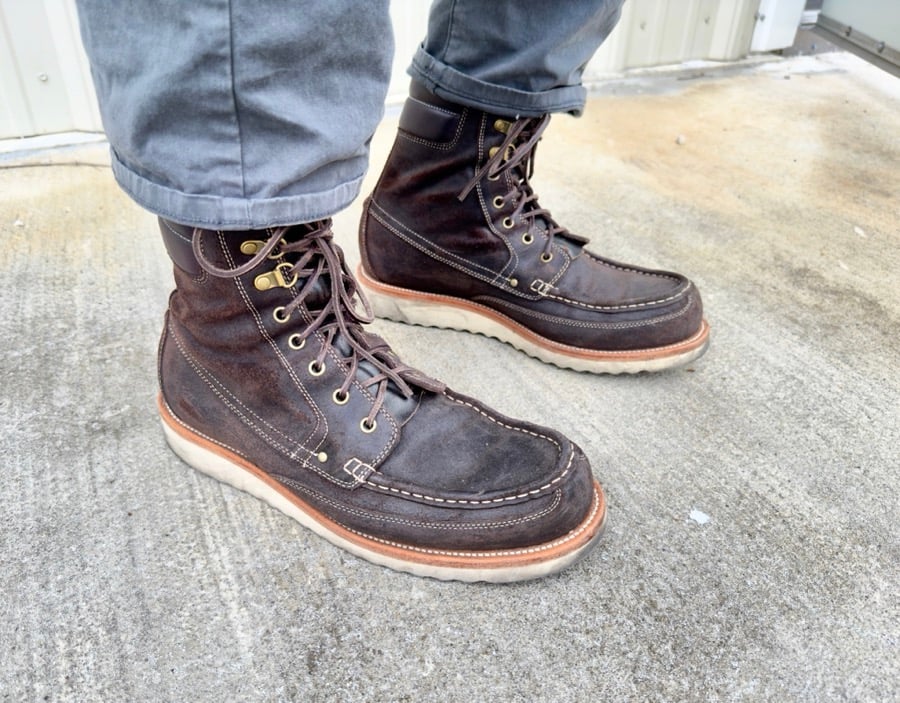
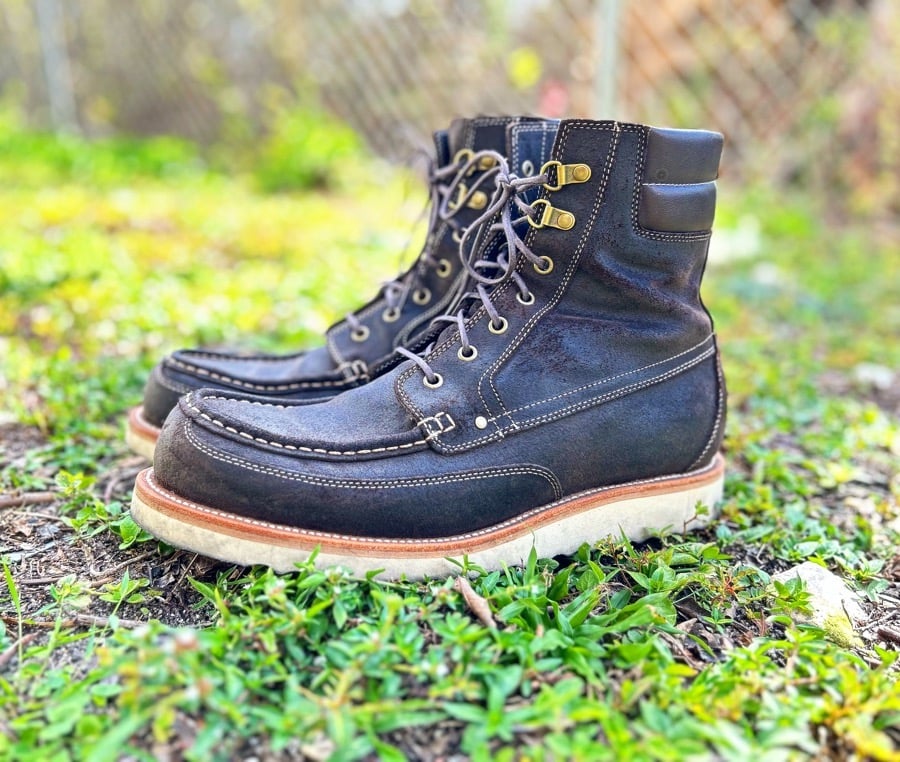
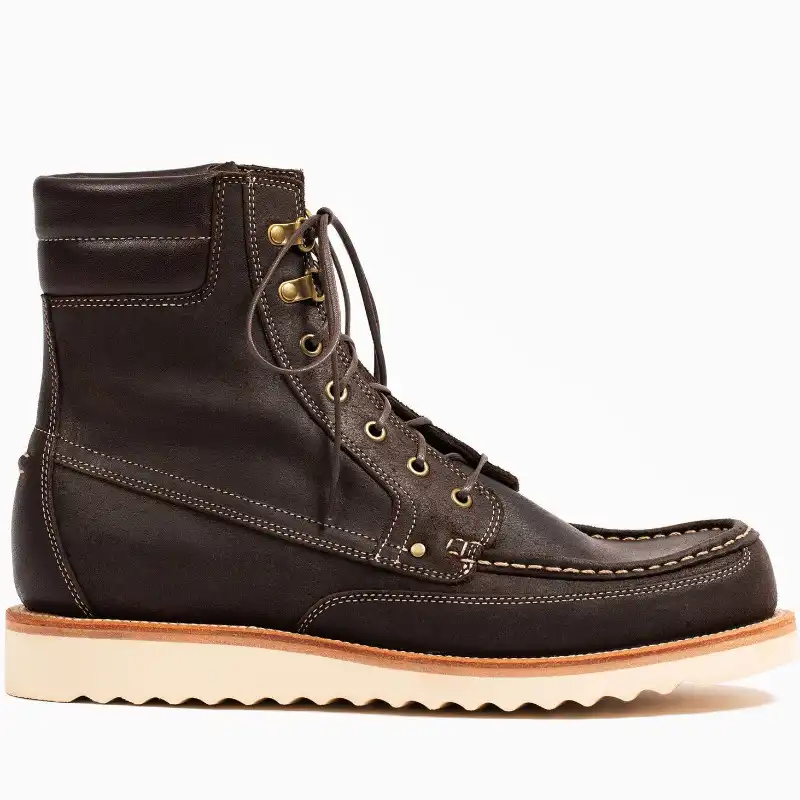
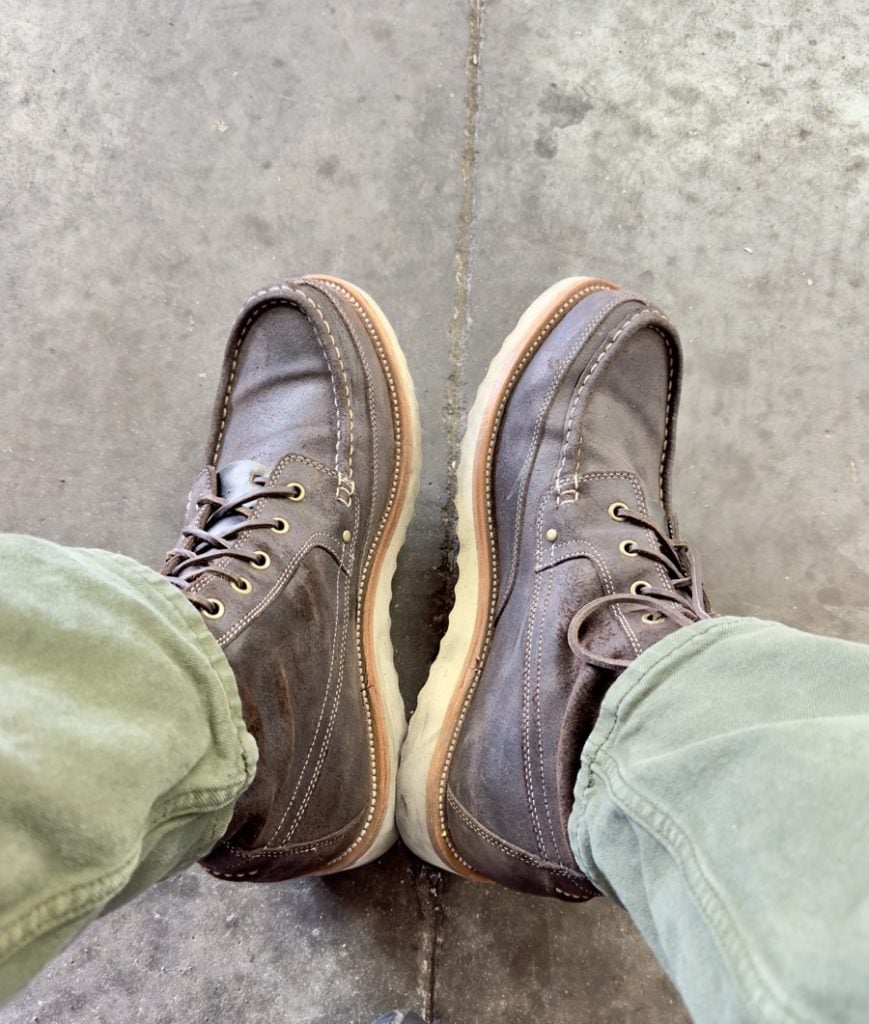




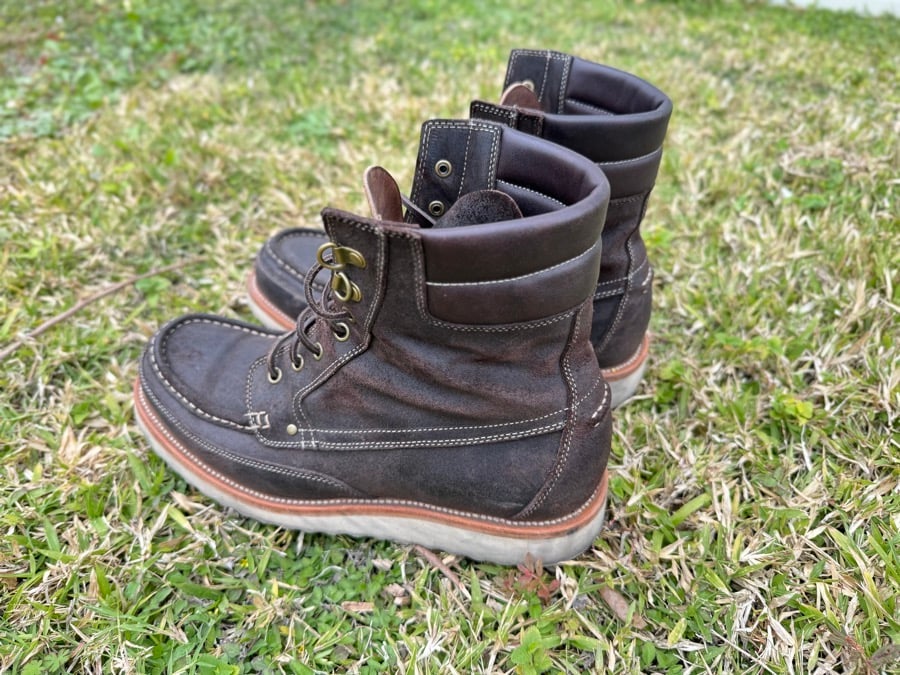
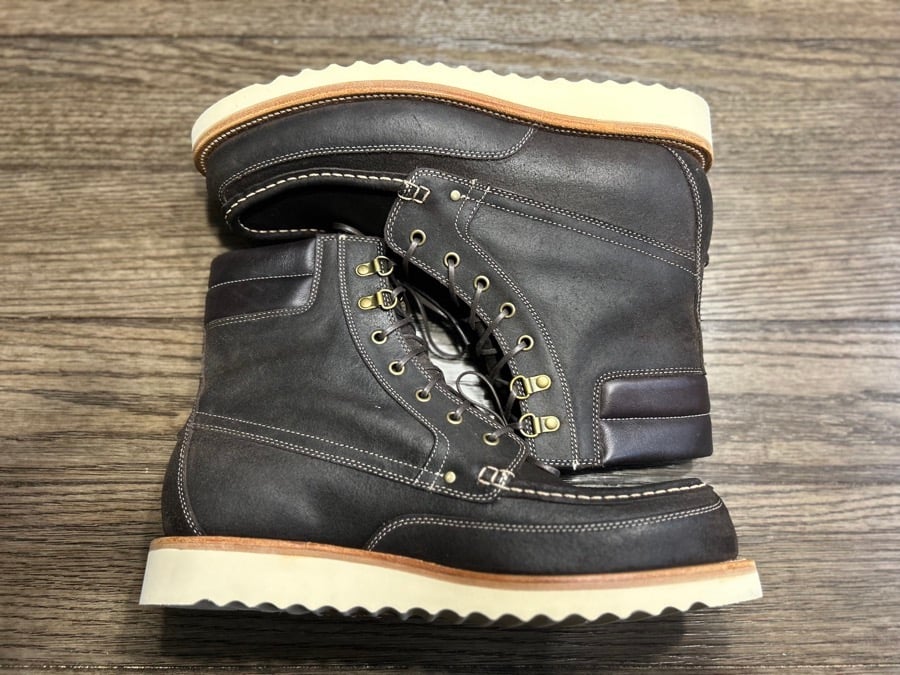

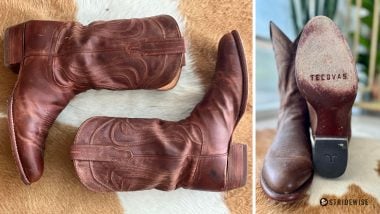
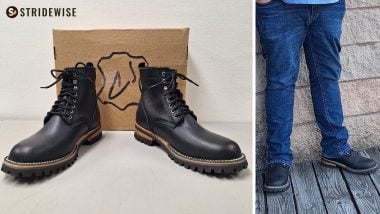
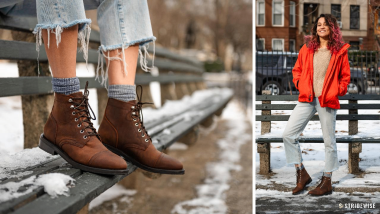


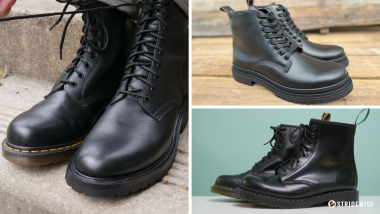


Join the Discussion